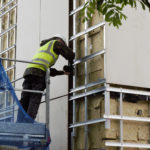Public sector cladding remediation: Why is the grant application process still so painful? Peter Johnson, Chairman of Vivalda Group (the UK’s leading distributor of non-flammable façades), believes that the good intentions of The Ministry of Housing, Communities and Local Government (now The Department for Levelling Up, Housing and Communities) are being undermined by an onerous and over-complex application process.
The Grenfell Tower disaster happened more than four years ago. Yet it still casts a long shadow over the UK’s social and private housing sectors. Back in 2020, the then Housing Minister Robert Jenrick (replaced by Michael Gove as Secretary of State for Levelling Up, Housing and Communities and Stuart Andrew as Housing Minister) announced a fund of £1.6bn to fix affected high-rise buildings. Then in February of 2021 we saw an additional £3.5bn — designed to kickstart building contractors to commence work on unsafe buildings over 18 metres.
Since then, progress from the local council and contractor’s perspective has been frustratingly slow. While the funds initially sound impressive — it is now widely considered that the £5bn figure will need to increase significantly (some say tenfold) to adequately make good all of the buildings at risk as a result of hazardous cladding. Gove’s recent announcement that he would be ‘going after’ those businesses that profited from the sale of unsafe cladding products signals a new line of attack from the Government. Certainly, those responsible for the sale of dangerous cladding, insulation and other aspects of the ill-fated Grenfell Tower can write-off any future government-funded work.
Non-ACM remediation update
While the progress to remediate the 470 plus* towers affected by unsafe ACM cladding is now well underway, the Building Safety Programme is focusing its efforts on what is known as non-ACM projects. These buildings comprise other materials (such as laminates) that are now deemed unsafe as cladding for high-rise structures.
The recently confirmed government funding announced for the remediation of non-ACM buildings is relatively modest at £967m, with only £125m of this being prescribed for social housing.
Latest figures from the Government (January 2022) show that of the 218 grant applications received from public sector bodies, just 108 have been approved. Due to the fact some public sector organisations had submitted applications for more than one building, this translates into approved funding for 119 social housing remediation projects. While these figures are encouraging, they are not remarkable and suggest ongoing issues with the onerous application process.
If we look at the 250 public sector buildings that have applied for the non-ACM repair grant, 119 have been given the nod, but 71 of these have been rejected or withdrawn outright. A further 60 projects are classed as being ‘under review’ according to the Building Safety Fund’s latest update. That’s an application failure rate of close to 30%. To put it another way, if you are a council applying for a cladding grant, you have a one in three chance of failure.
Complex application
What’s happening here? First off, the application process itself is highly complex (according to those council officials and contractors I have spoken to) — making the process to apply for funds slow, expensive and painful. “One wrong entry on a page and the whole application needs to be completely restarted’’ is a typical response to the process. We also see that there are still significant numbers of project funding applications stuck in the pipeline awaiting further clarification before final approval or just waiting for that final bureaucratic tick.
Last year we saw a high proportion of ACM grant applications being categorised as ineligible or incomplete. This appears to be the case with non-ACM grants in the social sector. We may well need a simpler application process and certainly more proactive support to help local authorities and their contractors to correctly complete this onerous and complex application process.
Further liability issues
The contractual details surrounding the release of funds have also deterred potential applicants. Issues such as: funding penalties relating to late delivery, liability for poor workmanship associated with the original cladding system and insurance cover for the project have led to contractors questioning their confidence in the funding system and how much risk they are prepared to expose their businesses to. As the economy picks up, we have to remember these same contractors, who are in limited supply, have other options many of which are much less risky and simpler.
In addition, there is the part funding scenario created when assessment consultants or contractors peel away old cladding material only to find nonconforming insulation, framing and fixings beneath — all of which needs to be replaced. In this regard we need to remember while the Government is funding the replacement of illegal cladding boards, this does not include other elements within the façade system — which can easily double the overall project cost if total replacement is required.
Another hugely significant cost that appears to have been overlooked is that of accommodation for residents while remediation work is undertaken. While not needed in all cases, it can be quite significant. The challenge is enhanced if we consider that it is needed in an environment of a chronic housing shortage.
People and materials
Finally, labour shortages (already a challenge before the recent exodus of overseas workers) mean that the construction industry is struggling to find enough skilled installers to undertake the remediation work. Ironically, Michael Gove’s well-intentioned proposal to lower the height limit for eligible buildings from 18m to 11m will exacerbate this challenge.
The correct installation of cladding — including fire breaks, insulation, fixings and boards — is not a simple task and requires specialist installers — many of whom have come from mainland Europe. These are projects that must be done correctly — however skills shortages and the lack of available training within and for the contractor market will surely act as a further brake on progress.
There are also major material supply issues, with some contractors quoting 20 plus week deliveries on hard metals, insulation. Not to mention recent volatility in timber and aluminium prices — making cost estimations extremely difficult.
Looking ahead, despite the lack of materials and labour and the ongoing contractual discussions, we will start to see more non-ACM recladding projects coming on stream. In fairness, the MHCLG (now DLUHC) has faced a momentous task and they should at least be given credit for their genuine efforts to pull the industry together to bring non-specification cladding up to standard. However, the grant application process is still not bringing confidence to the remediation process.
* NAO quoted in Roofing Today (June 2020)









